I have completed my first semester of my UnBFA, and it totally didn't go how I expected. But that might be a good thing.
I set out an educational plan at the beginning of the semester. First, I wanted to teach myself surface design. I am proud to announce that I have achieved my goals in that regard. My work is very much improved, and people seem genuinely impressed when I show it to them. I get a lot of joy out of what I make. Through practice, I have grown so much as an artist. It's really weird for me to be tooting my own horn like this, but damn, I'm getting better! I can't wait to see what the next few months will hold as I continue to grow.
I finished my design book. There weren't as many practice opportunities as I would have liked, but I am starting to see the principles being applied to my work. My skills have improved enough that I can actually explore different ideas, particularly in form and color. So that didn't quite go how I thought, but it certainly has changed my work, and I think it's for the best.
I didn't get to work on drawing as much as I would have liked. However, my drawing did improve. This is partly due to the study of value in my design book, and partly due to having the tool of a blending stump. I did not learn to draw from imagination (something I am currently weak at) but I will continue to work on my drawing from observation, at least for a little while.
I didn't get to Art History at all! Fortunately I studied it a bit in high school, so I'm not completely clueless.
I didn't finish those business books that I intended to read. I had to actually run a business, though. I watched several Art of Photography podcasts, which did improve my photography a little. I listened to Art Biz Blog podcasts and read some of the website. This site is tremendously helpful and I hope to continue to study it. I learn something every podcast or blog post. Also, I am happy to announce my latest development in my business: I'm going to be in the Crafty Underdog craft fair! It will be January 8th. It's not a lot of time to prepare and I'm going to be scrambling trying to come up with displays and business cards and stuff, but it's a start. I'm also working on three large commissions that are consuming my time and energy. They are sort of like term-end projects. Very exciting. Furthermore, I am working on my first series that is intended to be more on the art side of the continuum and less on the craft side. I am hoping to get into a show, somewhere, sometime. So this business thing is going somewhere.
I did not get to go out to galleries and see as much art as I would have liked. Practicalities of life made this difficult. I did make it to one excellent lecture and one mediocre one (albeit with great art) and am keeping my eyes peeled for more. I have gotten to volunteer at the Museum of Contemporary Craft a few times now, and I'm making great connections there and learning some of what it takes to run a museum (it takes a whole lot!). One of the advantages of volunteering is that I also get to see the exhibits.
I am also taking it upon myself to improve my hand embroidery and am looking for a way to learn tatting. I'm not yet sure how I will incorporate these things into my work, but I am sure that they are important!
I am starting to form plans for next semester. I will have to continue to study surface design and am going to try my hand at some small shibori projects. These will involve stitching a design, pulling the thread tight to bunch the fabric, dyeing it, and then undoing the thread to reveal a pattern. I will have to do this on small pieces at first because it will take me a year if I try to do it on a tablecloth or something. Additionally, I'd like to work on my weaving a bit. I've only woven one project on my loom (due to lack of funds for suitable yarn) and would like to continue to practice. I need to learn to dress the loom by myself, which is a little daunting but I've done it twice now with supervision. So I will try to hunt down some yarn that will work.
In drawing, I need to actually get that drawing book out of the library and practice more. I might continue to work on drawing from observation for the time being and learn to draw from imagination in a future semester. Hopefully I will also be able to study art history this semester, but my focus will probably be on other things and I might have to let this slide a little longer.
Business study will continue unabated as I learn to run my business. I think it will be much the same, bopping around finding what I need and then implementing that.
I will also be taking my first "continuing education" class this semester. Really, it's just an hour or so class that cost me five dollars, and it's not even fiber-related, but there you go. It's something and it's getting me out meeting people. I will continue to listen to various podcasts (I probably have hundreds of hours of podcasts now) to learn more about the art world. My husband has also tracked down episodes of Art:21 online, which is a great series and very educational in contemporary art.
So, that's my end of semester report!
I have been working on some new pieces. Lately, I am into incorporating some of the ideas that I encountered in my design textbook. First, I have been looking at color. In this piece I was incorporating complementary colors. Those are the colors that are opposite each other on the color wheel. This one is a study of red and green. It's not particularly Christmasy, which is a risk when working with those two colors. The red was pole-wrapped and the green was tie-dyed. I machine-embroidered in black on top of that. I like the contrast of the two colors, along with the black. This one is a study of analogous colors, or colors that are next to each other on the color wheel. I started out with the yellow, which is pole-wrapped, and then pleated with green on top of it. Next, I added the orange swirls, which are block printed. This wasn't enough for the composition, so I added the machine-embroidered blue circles. In doing so, I actually created complementary colors, the blue and orange. I chose a circle for the embroidery motif because it was similar in shape to the swirls but not exactly the same. In this way, I incorporated both harmony and variety. In this one, I fold-resisted in orange, added glue-resist swirls, and painted with yellow. Then I block-printed the orange swirls on top. This one shows analogous colors better than the last one, and uses more harmony than variety. I was a little disappointed with my glue-resisted swirls, because they are hard to see, but they turned out pretty well in the photo.
I am also working on a tablecloth for some friends. So far, it has taken me half an hour to pleat it, and then 45 minutes to tie it for tie-dye, and another half hour to take the elastics out.
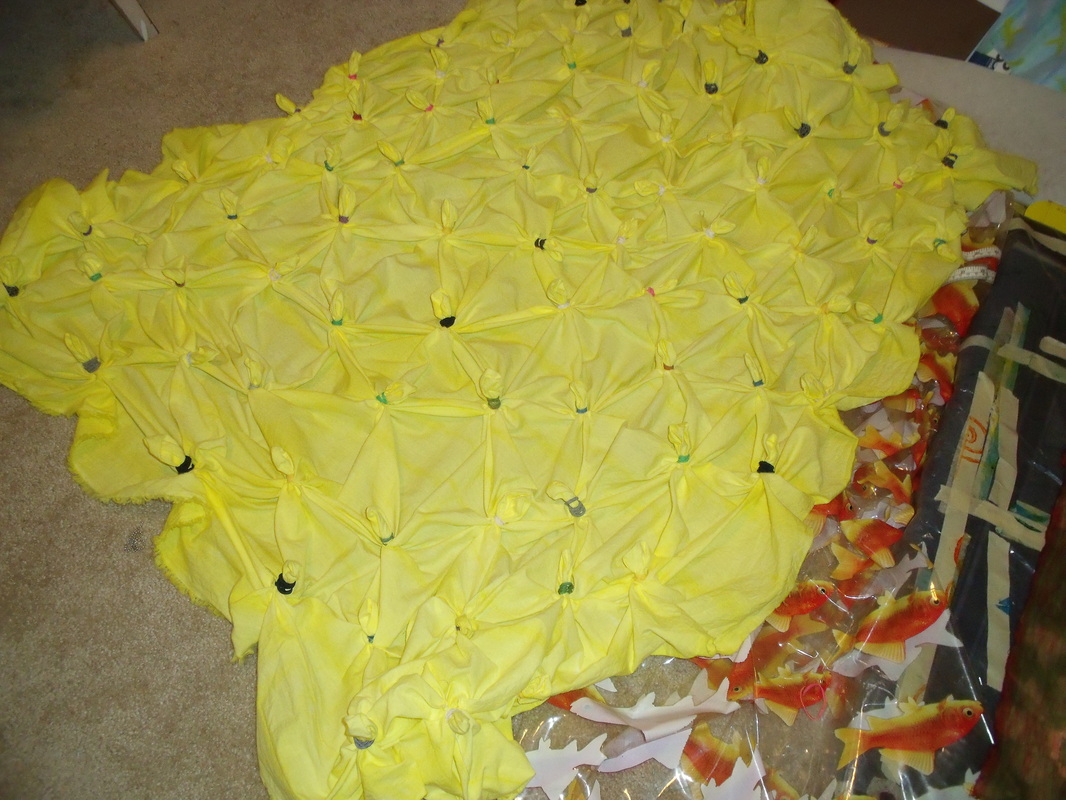
After tying for tie-dye. It's kind of pretty like that, but really not practical for a tablecloth.
Day 21 took place over a number of days, as I've been sick with a nasty cold recently and haven't always had the energy I needed to do all my work. But I chipped away at it and this is the result. The information I am presenting is not in the order that I did it, but rather the order I can keep it all straight in my head.
My warm-up was to "listen to what nature was telling me". The book even suggested that I consult a book about nature omens. Now, I don't actually believe that there is a such thing as a nature omen, so I had to make of it what I would. It did occur to me that I don't spend a lot of time just observing nature and appreciating it. The book suggested that I do a visual journal entry about it, but I didn't even know where to begin, so I decided to go out with my camera. I figure that photography can be a kind of a journal, and I am eager to improve my photography. So I went for a walk with my camera and took pictures of nature changing for fall. I particularly liked the red red leaves and the squirrels that were so happy with their acorns.
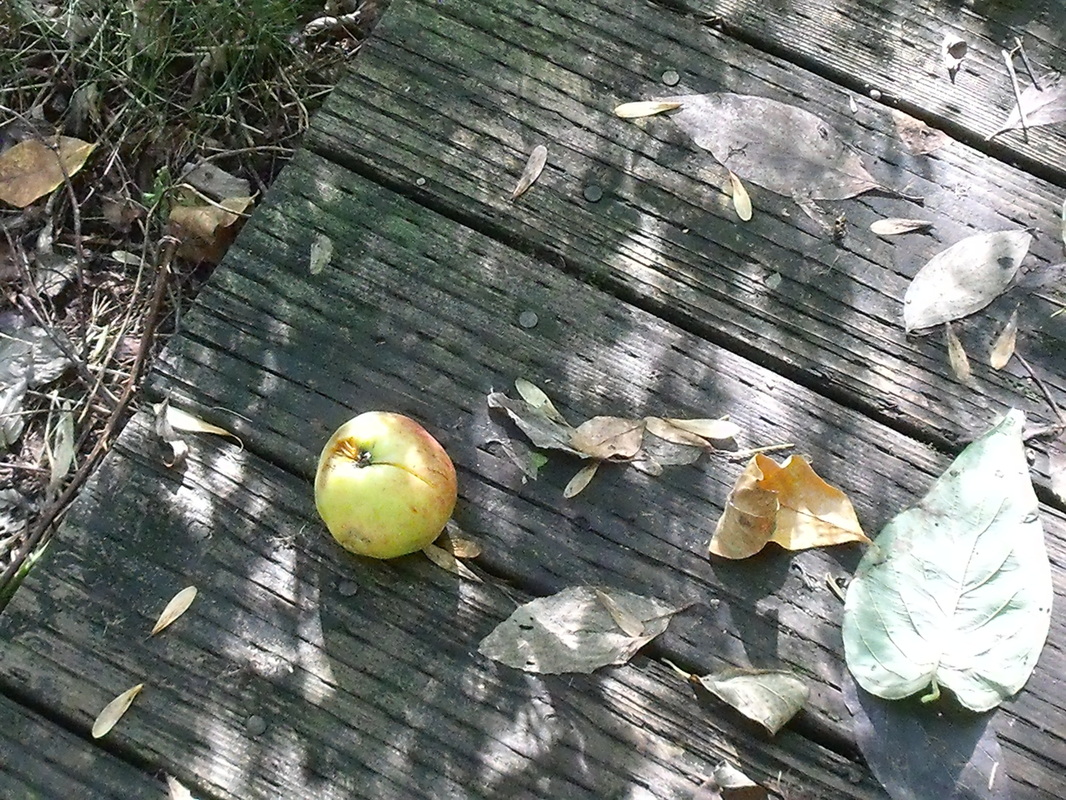
Autumn fruit.
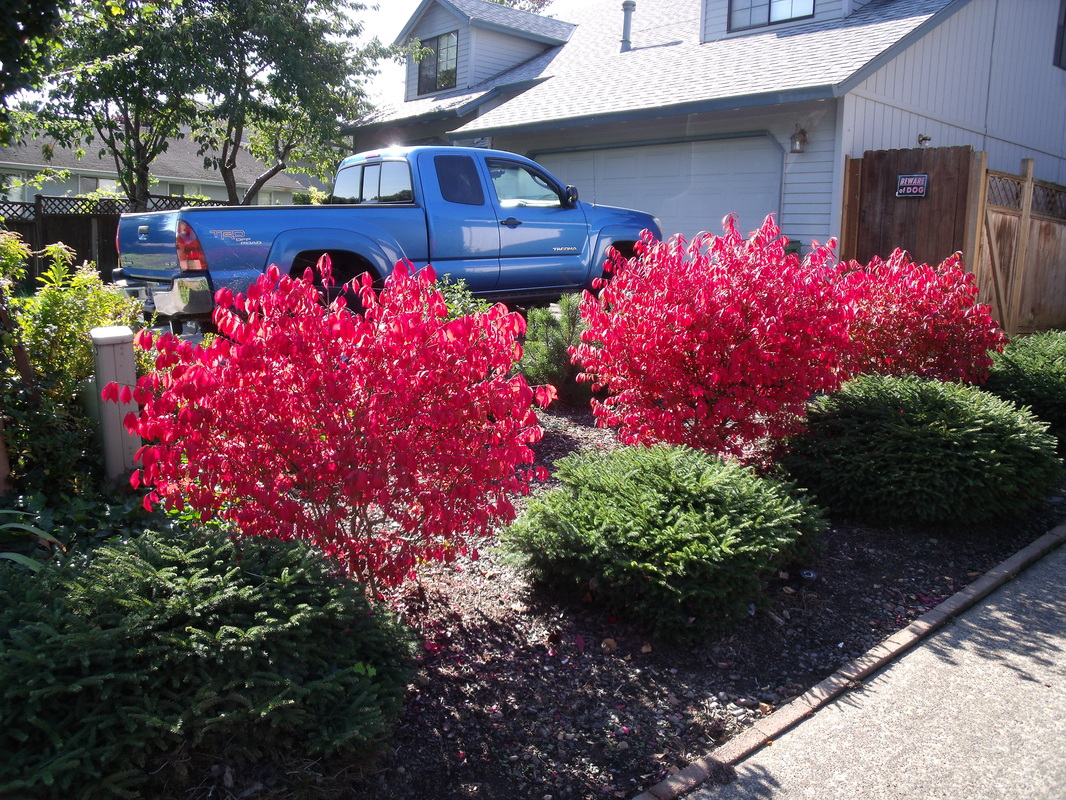
So red!
I watched a fantastic podcast about the Jawaja leather workers of India. They were doing a presentation via Skype, with a translator. Theirs was a very inspiring story. Thirty years ago, they were so low-caste that they weren't allowed to draw water from most of the wells. The traditional way of leather working in India is to scavenge for dead cows, as you're not allowed to kill a cow. So this was a despised profession. The leather workers were very poor. Their elders decided to ban the scavenging of dead cows and work on shoes (feet are kind of taboo in India) in order to raise their status. This had the unintended effect of making it even more difficult financially for the leather workers, as they had to buy processed leather, and couldn't sell as much. Eventually, they decided that they had had enough and began to work with design schools and craft councils. They helped develop products that could be marketed overseas. They began to sell to Maiwa and made enough money that they could eat twice a day (they were eating once every two days before that) and own houses. Since the presentation, customers have been so interested in the leather work that they have had to carry extra stock. Their bags and purses are very popular and they always have a large selection on their website. I was very happy to hear about the improvement of their lives and I hope they become even more prosperous. Their social standing in the village has also improved and now they are allowed to draw from all the wells. I have been working on a drawing of crumpled paper. This is going to take me a few days., I think. It requires a lot of concentration and patience. So far, I think it looks like cloth, but we will see how it looks when I am finished. I will post pictures as I have them. I watched more podcasts on the Art of Photography. The first one I watched was about scanning negatives, and it reminded me of my first full-time job as a digital scanner. It was a good refresher, and I learned about adjusting the histogram more finely than I did at work to improve detail in the photo. The next one I watched was on dynamic range, which is the range of values in a photo. Ideally there should be a wide range of values in order to show the most detail, unless you are doing high contrast on purpose. You can adjust the values in the computer to improve the range. The next one I watched was pretty cool, on tethered shooting. This is where you set up your camera to load pictures directly onto the computer so you can tell if they are exactly as you want them (it can be hard to tell on that little screen). That way you can adjust your settings to tweak the photo. This technique is used especially for catalogue photos. The final one that I watched was on time-lapse photography. It's very interesting because you have to set your camera up to take these photos at set intervals and then not touch it. You can't adjust the lighting levels or anything or it will look strange. There are programs that you can get for your computer that will play the time-lapse and you can make a little video. In my design book, I reviewed the chapters on shape and texture. In surface design, I am proud to say that I have my bolt of cloth! I have spent the last couple of days preparing the cloth and have cut the pieces for the order for my brother. I have also been working on dyeing some other pieces that I was experimenting on, and I am washing out those pieces now. It doesn't sound like I've done a lot but preparing an entire bolt of cloth takes a long time!
Well, I'm feeling pretty sick today, so I'm taking a day off. However, I did stuff yesterday so here's my report. I started out with a podcast. It was by an artist who talked about her commissions. I am doing mostly commissions these days, so I was interested in what she had to say. She sort of built her own fiber art education, since she had studied ceramics in her undergrad and didn't have time to go back and study fibers. She did this by working in a theater costume department. She specializes in wearable art that can be worn by everyday people, not just displayed in a museum. She liked working on commission because she enjoyed the challenge of trying to meet her clients' needs while still being creative. In some cases she has even used a different medium, if fiber wouldn't be suitable. That's something I have to work on: I can do what I can do but if someone asks for something at all outside of that, I get befuddled and am unable to do it. She also had an interesting payment structure, where she collected the payment in thirds: one for the initial materials, one mid-project, and one on completion. I am not sure why you would need the mid-project collection but she said that it was what worked best for her. She also talked about how temperamental her indigo was: you have to harvest and use it at the right time or it won't work at all. One year she missed harvesting it before the frost, and the frost turned all her plants blue. She said it was stunningly beautiful and didn't seem at all disappointed that her crop was lost! Next, I did a warm-up. (Crazy, podcast before the warm-up!) The assignment was to research cultural symbols of a culture that spoke to you. I have been interested in (obsessed with) Indian culture since I was about 14 years old. Now, admittedly, most of this obsession has revolved around food. I went through my Bollywood phase and my wanting-to-wear-a-sari phase and my Ravi Shankar phase and even courted the idea of becoming Hindu for a while, but those were all things I passed through. Food has been the constant, especially vegetarian food (I am beginning to branch out into meat now). So there were actually a number of symbols that I didn't know about, or at least didn't know the importance of. I got my information here. My favorite symbols were the Deepam (a little butter lamp used for worship), the coconut, and the lotus. The Deepam is said to remove impurities, the coconut to bring prosperity, and the lotus, among other things, represents detachment (I believe that's in the Buddhist sense). I reviewed line in my design book. I looked at measure, type, direction, location, character, as well as line and shape, line and value, texture, color, spacial characteristics, and representation and expression. Learn more about line here and here. Finally, I did a drawing of a little woven box that I got some spices in. I didn't get a chance to do surface design yesterday, because the glue resist I had applied wasn't dry yet. If I can rustle up the energy to do it today, I will, but so far things aren't looking so good. I also have received a deposit to go purchase supplies for my next commission, but I think I'm too sick today to go out and get it! Hopefully I will feel better tomorrow and I can hop to it.
I sort of did this day over the span of two days. Yesterday was a holiday (Columbus Day in the US and Thanksgiving in Canada) so I only did a little work. Also, I'm having trouble with my productivity lately. I am learning stuff but not at the rate I would like. So I will see if I can ramp things up a bit over the coming week. I listened to two podcasts yesterday. The first one was about a Shibori artist from the UK. She worked primarily with Indigo, but also with iron rust. She does beautiful, intricate shibori work, which leaves me in awe. She takes quite a lot of time very carefully stitching, dipping multiple times in the dye vat, and then carefully undoing the stitching. You can see a little of her work and the kits she sells at http://www.callishibori.co.uk/. The next podcast I listened to was by a textile designer-turned cultural anthropologist who had a little money that would either let her work in her studio for six months or allow her to travel to India to study textiles. She didn't know which one she would rather do, so she flipped a coin. The coin "chose" the trip to India. She has traveled all over India, and has specialized in studying the block printers of the Kutch region in Gujarat. She specifically studied ajrakh printing. She absolutely loves traveling in India and has arranged many exhibits in the West. For business study, I watched some more of the Art of Photography episodes. The episodes I watched were all about developing film. I won't be doing that anytime soon, but it was a fascinating process to watch. The developing fluids were poured into a little light-proof case that held the film. There were three different fluids, but I can't remember what they all were. I wonder if photographers today miss this sort of process, or if they find Photoshop gives them better control. In design, I did a review of the chapter on form, doing sketches as I went. I looked at variety, balance, and dominance. It was a good review to make sure I understood the terms. I will have to give this book back to the library soon so I need to finish my review to make sure I understand all the concepts. Finally, I finished off some bookmarks, as well as a sample of a project that I am doing for my brother and sister-in-law. I worked on a few other items as well, applying the glue resist, stitching embroidery, and the tedious work of ironing everything. I find that working with cloth is half tedium and half creativity. It's a bit like cooking, where you spend half your time creating and half your time cleaning up or doing repetitive chopping or something. When I put on some music and daydream, the tedious stuff is not so bad, and I can get excited that it will lead to creative stuff. Anyways, I took some photos of my finished objects. 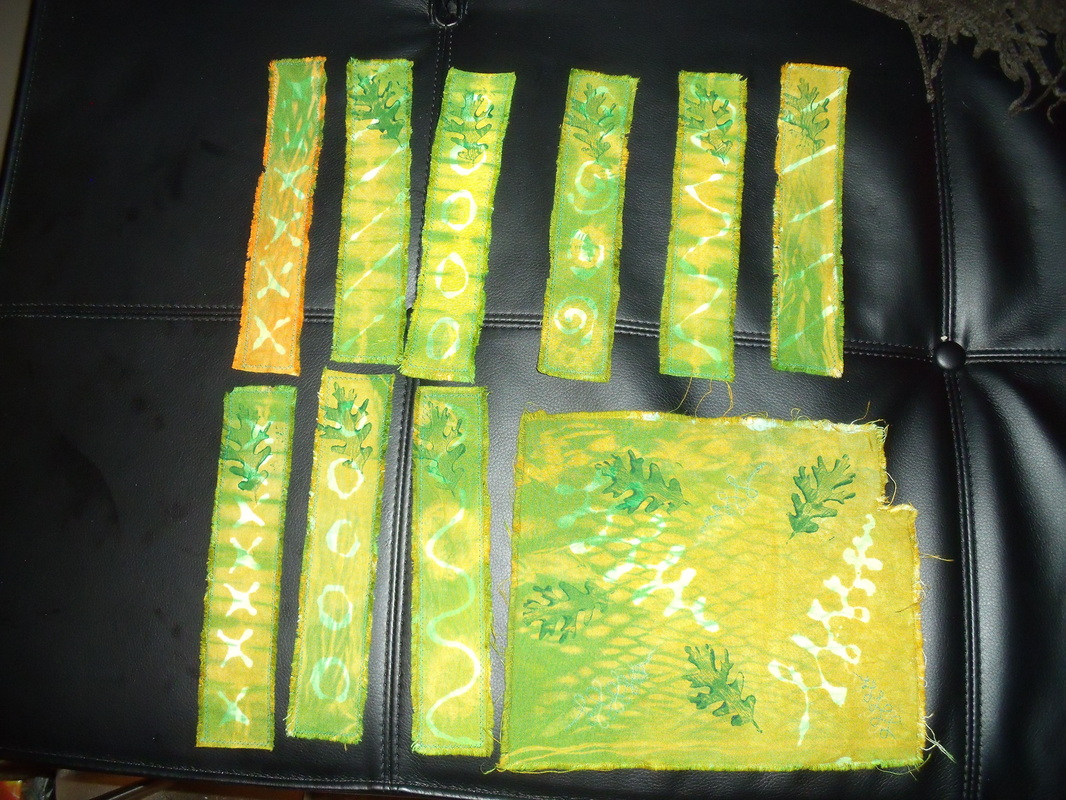 Bookmarks and sample. In the future, I will leave the leaf print off the bookmarks, as I feel that it takes away from rather than adding to the design.  Close-up of sample. Pole wrapped and dyed, glue resisted, overdyed, printed, and machine embroidered.
Yesterday, I had a great experience with my friend Amber. We sort of had a skills-exchange party. Amber showed me some things about sewing and I showed her some things about knitting. We had a great day. I made a pillowcase, which doesn't actually fit any of our pillows. I know how to do it now though. Not difficult at all. From soup to nuts I think it took me under an hour. We also worked on a skirt (just the muslin, I don't intend to wear it). Anyways, I had such problems with the pattern and the book that I think I am going to quit this one and make something else instead. I have another book that the pillow pattern comes from, which might be a better fit for me. Also, Amber left some patterns for me to try, so I'm going to give those a whirl. I hope we can have another skills exchange party again soon!
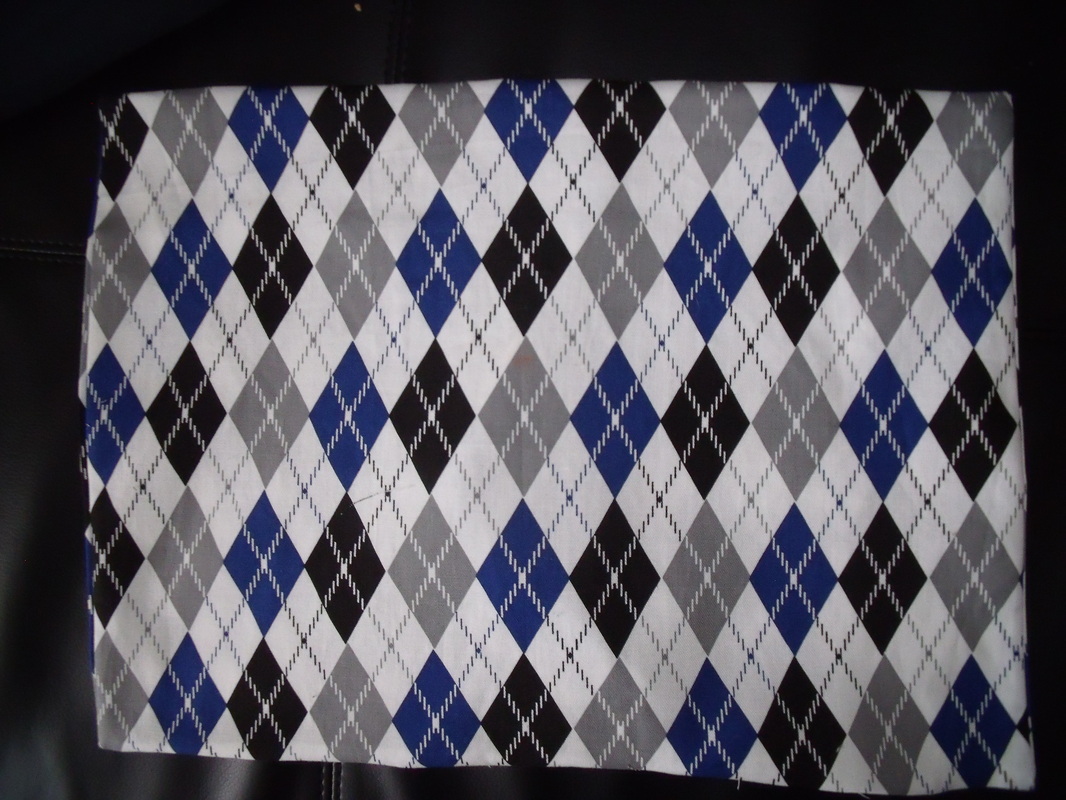
The front of my pillowcase. I like argyle.

The back, with envelope opening showing. That's how you get the pillow in.
For my business study today, I watched four more episodes on The Art of Photography. The first episode was on filters, which are more appropriate for film cameras than digital. With digital, it is more effective to use Photoshop than a filter. The second episode was on metering without a light meter, which involved changing the aperture and the f-stop. I also learned that lots of photographers take slightly darker and lighter photos to make sure that at least one turns out as they had hoped. The third was on a photographer who put together a book called The Americans, and had sort of a photojournalistic style. Finally, the last one was about composition, and there were many elements to it other than the rule of thirds. One thing that stood out was the use of triangles, often creating points with eyes. Most of these triangles were right-angle triangles. Another think I liked was the use of curves in photos, usually on one of the stress points created by the thirds. I finished the last chapter in my design book, and will be going back to invent exercises for each chapter to make sure that I have grasped the concepts. This last chapter was on time and motion. It was a pretty short pattern. Motions on the picture frame are intended to slow down the gaze of the viewer, who will usually try to look at something quickly. Motion can be implied by line direction or shape position. The sequencing of images gave rise to animation and moving pictures. Some artists, such as the Cubists, tried to give the impression of moving around the subject by showing multiple viewpoints. This can be seen in Cezanne's works, where parts of the table don't line up and where some objects are viewed head-on and others are viewed from above. Sometimes images are superimposed or blurred to give the impression of moving around the subject or to suggest motion. Think of cartoons in which the character runs, and his feet turn into multiple feet moving very quickly. The chapter has a short history of moving pictures, which I won't get into here, and also discusses video artists. Additionally, computers and multimedia can be used in art now. Motion can also be implied in three dimensional work, again by showing multiple viewpoints. Additionally, there is kinetic art, which is usually sculpture that actually moves. In dyeing today, I had an interesting experiment: trying to make brown. Theoretically, brown should be dark orange. I don't have black to add to orange (which I can make with red and yellow). What I did was to mix up some golden yellow, which is close to orange, and added a tiny bit of blue and a tinier bit of red. The dye looked pretty brown but it seemed a bit on the orange side when I painted it on. I won't know exactly what the color will be until I've washed out the dye. I am hoping it will be brown, but I can keep mixing if not. I didn't saturate my cloth with dye so I'm hoping I can dye it once more if it's not brown enough.
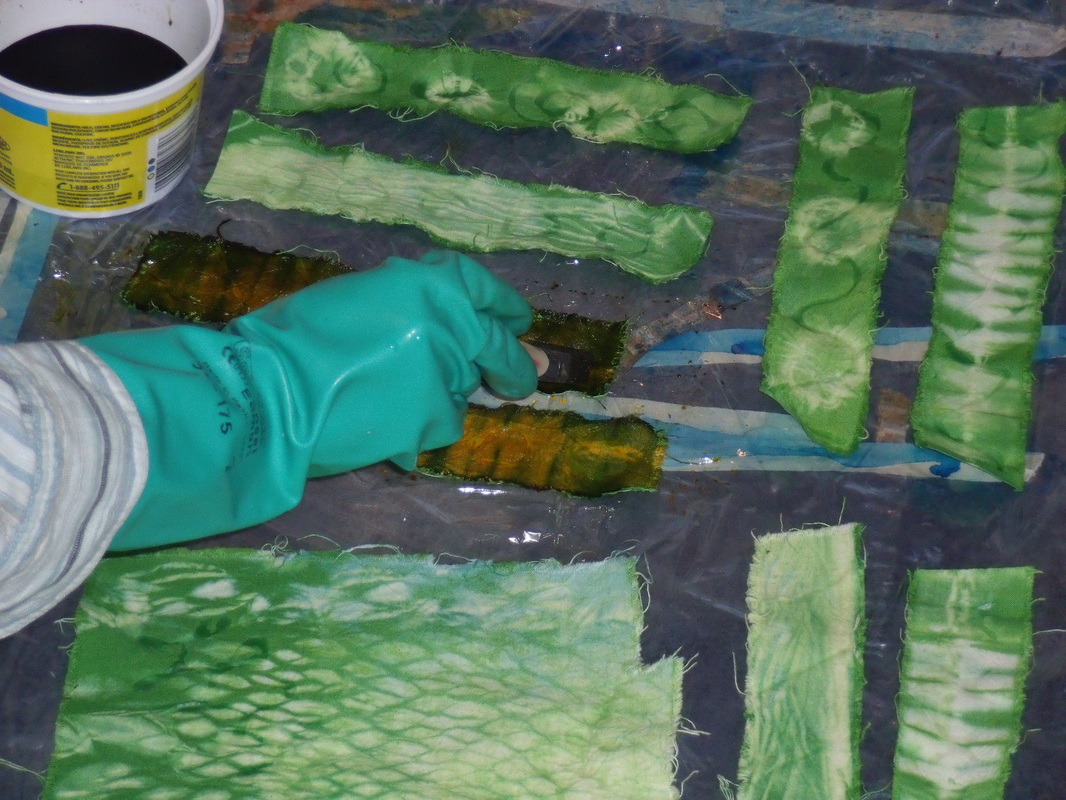
The bottom one turned out very orange. I tweaked it a bit after that.
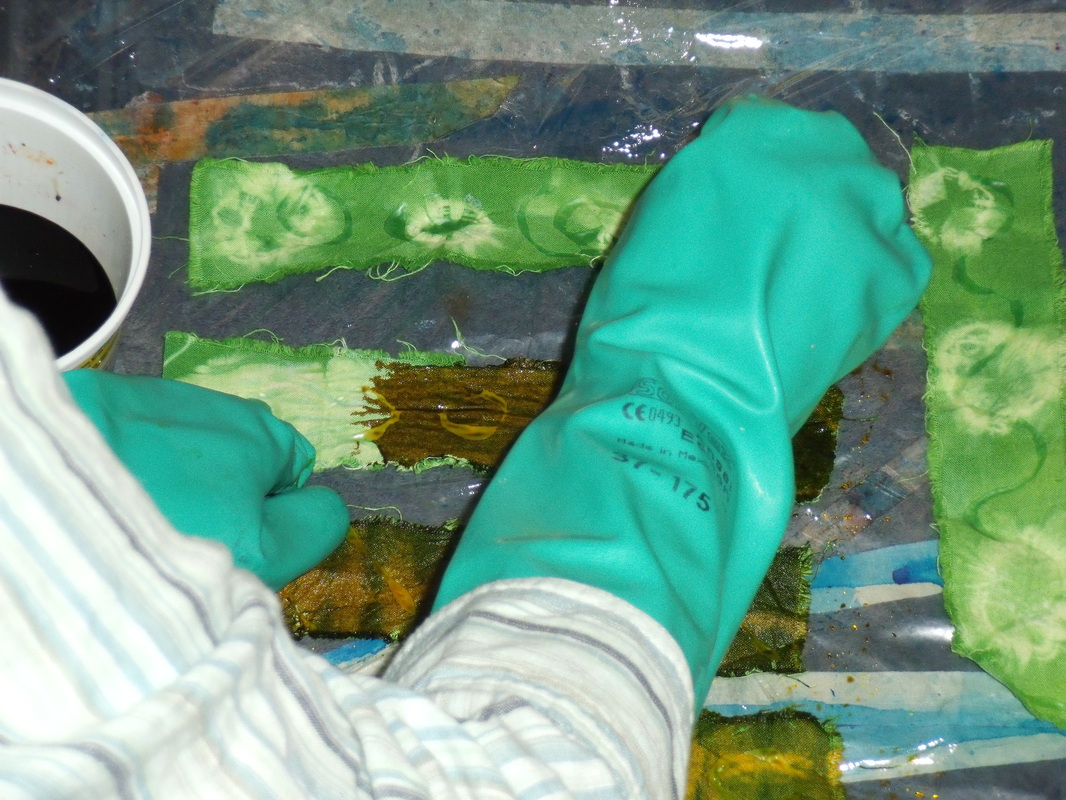
Looking browner, but still a bit orangey on the resist. We will see.
Started a bit late this morning, but got everything done that I wanted to do. For business study, I watched more podcasts from the Art of Photography. The first one was on handheld light metering. I don't have a light meter but I can see that it might be a good investment in the future. A light meter helps you decide how to arrange your aperture and shutter speed. My camera has a built-in light meter in it, as probably does yours. When this is the case, the camera "decides" automatically on the shutter speed and aperture. Again, that's not something I have control over in my point-and-shoot but it is something to be aware of. The other two podcasts I watched were about lenses. All cameras have lenses, and most actually have more than one inside. On an SLR you can change the lenses to suit your needs. My camera doesn't have this option, but it does have settings that simulate different lenses. I don't know if these have problems with distortion or not, but I expect they would because all lenses cause some type of distortion. The trick is to get the distortion you want for your particular photo. These podcasts make me really want an SLR! But that is not an option at the moment and I can live with what I have. I haven't always been lucky enough to have any camera at all, so I can't really complain. In my design book, I studied space. I actually started studying the chapter a couple of days ago but didn't finish it until now. There is a lot of wordiness that I didn't understand in this chapter, but I understood as soon as I saw the picture illustrating it. Unfortunately, I can't show you the pictures from the book, so my words will have to do. There are two major types of space in two-dimensional art: decorative space (flat-looking surface) and plastic space (looks like it has depth). Plastic space is further divided by shallow space and deep or infinite space. Shallow space looks like the picture has some depth, but not very much. The artist might have manipulated some tricks to make the image look flat. Deep space looks like how we would actually see something in the real world (again, the artist uses tricks to make us think that it is as we would see it) and infinite space is just what it sounds like. There are spacial indicators. Sharp detail looks close to us, and diminishing detail looks far away. Larger items appear closer than smaller items. The position of a shape can make it appear closer: the horizon line is usually at eye level, so shapes below that on the canvas appear closer than shapes above it. If an item is overlapping another item, it appears closer. Transparency can be used with overlapping items to make them appear closer. Interpenetration is when planes or objects pass through each other, and depending on what is pictured, can create shallow or deep space. Fractional representation, which is seen in ancient Egyptian art, is when we picture a subject using those parts that best represent it in our heads. For example, in Egyptian paintings the head is a side view while the eye is full on, the torso faces forward but the hips and legs face the side. Converging parallels is when two sides of an object, which we know to be parallel, have sight lines pointing toward the same vanishing point. Linear perspective is a way of representing sizes and distances of objects in space. There are three major types of linear perspective: one-point, two-point, and three-point. One-point perspective has a single vanishing point in the picture, and was used frequently in Renaissance art. Two-point perspective has two vanishing points, usually located off the canvas. A view of a city might be a good example of two-point perspective. Three-point perspective is used when an exaggerated view is pictured. This can either be bird's-eye view or worm's-eye view. There are formulas for making sure that shapes in the picture will be spaced in a way that seems to suggest distance to our eyes, which I won't get into because there are so many of them. There are some disadvantages to linear perspective: it does not actually show things as we see them, you can only see things from one position in space, it can be monotonous, and the items pictured are distorted. There are other projection systems as well. Oblique projection does not have vanishing points, but does show a the side as well as the front of a shape, with the side at a 45 degree angle. It is used by engineers and architects. Isometric projection shows two sides of the object, both at 30 degree angles, as well as the top. Again, there are no vanishing points. It is used by drafters. Orthographic drawing, all objects are drawn perpendicular to a base line. It is used in engineering and industrial settings. Reverse perspective is seen in traditional East Asian art, in which the back of objects are wider than the front of them. Intuitive space is the creation of space without rules or guidelines. Lines can create space, appearing to recede or advance. Shapes can create space through overlapping. Value can create space as well: usually the lighter something is, the closer it appears, and the darker it is, the further away it seems, although this can be reversed. Texture can influence space: sharp, clear, and bold indicate closeness, and fuzzy, dull, and small textures usually suggest distance. Color can also indicate space: analogous colors create limited space, while contrasting colors create a lot of space. There is a way to create space called structured ambiguity, in which the shapes in the foreground and background seem to switch depending on what colors are around it. For this reason, beginning artists are usually encouraged not to frame their work with a black mat. Space is also crucial in three-dimensional work. Sculptures could be flat, or they could have open voids. They can be spaced apart enough that the viewer has to walk around or through them. Instillations are works that the viewer has to walk through to experience, and they use space as part of the art. I worked some more on my commissions and items for my online store. I had a lot of fairly boring work to do, involving prepping the fabric. However, I did get to do a bit of dyeing, all immersion this time. I am doing some pole-wrapped bookmarks and some tie-dyed ones. I also did a pole-wrap of a sample for the commission I am doing for my brother and his wife. They want green and brown natural-looking placemats and napkins, but they wanted to see a sample first. Fair enough: this gives me a chance to work out any kinks (like, how do I make brown?) before I start working on their actual project. I also washed out a cloth I dyed yesterday, using pleating, but it currently looks so unimpressive that I didn't bother to take a photo. I will use it to figure out how to create layers when the background color is dark.
I suppose the way to hell is paved with good intentions, and I had the best intentions to study while on my trip. Perhaps not surprisingly, it didn't work out that great. But at least I have done some studying. I listened to a podcast that was the first part of a roundtable discussion of prominent people in the worldwide fiber arts field. There was a woman who was an expert on fibers and the animals who supplied them; another who was the expert on worldwide embroidery; one who had a weaving cooperative; one who ran the store and foundation that supplied these podcasts, as well as doing a million other things to support traditional fiber artists in India; and another fellow whose area of expertise escapes me at the moment. They talked about what it was like to be working travellers: none of them traveled for enjoyment, particularly, or to take a vacation. They all traveled for their work. They were all trying to figure out how to balance intervention in the craft making process. For those who sold traditional work, they tended to encourage people to do the work native to their area, in a high-quality manner. Without these kinds of controls, some craftspeople might do low quality work to sell the craft, leading to its devaluation and the eroding of the skills necessary to produce it. Other craftspeople might be contracted to do work that is not traditional to that region, again leading to the erosion of skill, but also exposing people to the vicissitudes of the worldwide market (that is, if Indian embroiderers are doing Danish style embroidery, and Danish style embroidery goes out of fashion, they will lose their livelihoods. If they do the work that is native to their region, they will always appeal to collectors and those interested in quality regional work.) Some of the panelists were interested in keeping work exactly as it was, never changing. There woman who studied embroidery was dismayed because there was a certain area in India where young women would embroider elaborate pieces for their dowries. Now they embroider pillows for sale. The gentleman whose profession I can't remember pointed out that he had been criticized in India for wanting to "play God", or tell people what they could or could not produce. In the example of the dowry work, he said that many girls no longer bring dowries to the marriage, and if they have such incredible embroidery skills they don't want to use them on something that only their families will see, but on something they could make money on. If they made that money, they could spend it on their children's education and health care for the family and better food. All the presenters said that they don't like interfering, but when crafts are being produced for markets sometimes they have to enforce quality control. Sometimes, these businesses keep the crafts from dying out completely, as the children of many artisans want to be professionals instead. In my design book, I studied the chapter on color. It was a long and technical chapter and I had a lot of trouble with it. It will be difficult to transfer the information to dyes, as dyes have different properties than pigment or light. We see color because of how light reflects off of objects. Colored light is referred to as additive color. The primary additive colors are red, blue (which is close to violet) and green. Combined, they create the additive secondaries of cyan, magenta, and yellow, and when all colors are combined together, they make white. TVs and computers use additive color. Subtractive color is that which comes from pigments. It is called subtractive because pigments absorb some colors from sunlight and reflect others. For example, a green leaf reflects green and absorbs all other colors. There are color systems that drove me crazy. In the triadic color system, the primary colors are yellow, red, and blue. The secondary colors are orange, green, and violet (each one of these sets is a triad) Then there are intermediate colors: red-orange, yellow-orange, yellow-green, blue-green, blue-violet, and red-violet. An intermediate triad would either be yellow-orange, blue-green, and red-violet, or red-orange, yellow-green, and blue-violet. When all these colors are put in order in a circle, they form the 12-point color wheel ( go play with the palette at the bottom of this page). The colors directly opposite each other on the color wheel are known as complimentary colors. For example, the complimentary color of red is green. When a color is mixed with its complement, it grays and creates what is known as a tertiary color. For example, green mixed with a little red creates olive. Tertiary colors can also be created by mixing any two intermediate colors, so long as they are not next to each other on the color wheel (analogous colors). They are found on the inner ring of the color wheel. In the center of the color wheel is complete neutralization, which is a muddy grey. There are also neutrals, not on the color wheel. These are black, which is the absence of color, white, which is all colors, and grays, which are impure whites. Hue refers to the generic color name of the color, i.e. red, blue, green, etc. Colors vary in value, with the highest value color (yellow) at the top of the color wheel and the lowest value (violet) at the bottom. It is difficult to see the relative values just by looking at a picture, and it helps to photocopy the picture in black and white to be able to see the values. You can also lighten or darken hues. By adding white to a hue, you create a tint, and when adding black, you create a shade. Intensity refers to the brightness of a color. A bright red and a grayed red are the same hue, but the bright red has greater intensity. You can also increase the appearance of intensity by putting a color with it's complement, like green with red (maybe that's why Christmastime is so colorful?) Color relationships drove me a bit crazy too. There are complements (opposite on the color wheel), split complements (immediately on either side of the opposite color on the color wheel), triads, which we talked about previously, tetrads, which form a square or a rectangle on the color wheel (for example orange, yellow-green, blue, and red-violet), analogous, which are all the colors next to each other in a small range on the color wheel (say yellow to blue-green), monochromatic colors, which are the same hue but different values, warm colors (reds, oranges, yellows), cool colors (blues, greens, violets), plastic colors (red pops out on a page, blue recedes), simultaneous contrast (colors placed next to each other that make them look different), the emotional impact of color, and psychological impacts of color (i.e. red for anger, green for calm, etc). Color can be used in composition to create contrasts and depth, create mood and emotions, attract attention to something, describe objects, and create aesthetic appeal. In color balance, artists have to find an appropriate balance between harmony and contrast. There is more material in this chapter but I won't go into it, partly because it's about how printing works and I don't think that's applicable to me, and partly because I've been blogging for more than an hour and I'm getting tired! For business study, I read some entries from the Etsy blogs about how to make a living at Etsy. They emphasized good photos (something I have to work on), many product descriptions, and a good shop name. My previous shop name, Penthisilea, isn't great because it's hard to spell (it's actually spelled wrong in my shop) and if you don't know the legend, hard to remember. So I will be choosing a new shop name for my products. Also, banners are important, and you can hire an Etsy seller who does banners to create a better banner for you. They also remind you that photography, site maintenance, and packaging all take time, and this time should be accounted for in the cost of the item. Many people make their living off of Etsy (some even make six figure salaries) so good products and working at it appropriately, I should be able to make my living at it too. No drawing to report for today. Good night!
Well, my trip is getting in the way of schooling, as you can imagine. Between all the tasks I have to do and all the people I want to visit, this has been my first full day that I could do any schoolwork.
I should backtrack and let you know about a podcast I listened to last week. It was about a couple who grew and dyed with woad. Woad is a flowering plant whose leaves give off a pale blue dye. The couple had no background in dyeing, but they had bought a house in rural France and found a windowpane that had been painted a pale blue colour. They wanted to learn about this blue, and found out that it was woad. They have been in love ever since. Woad is paler and harder to work with than indigo, so it is not used much anymore. It has a long history of use, however, before indigo was common in Europe. Like most natural dyes, the dye had to be “fixed” using a mordant. In the middle ages and the renaissance, the mordant that was used was stale urine. The woad dyers would pay the townspeople to go drink beer for a whole weekend and then come back and pee into a barrel. A man who did this was called a pisser. I’m not joking! Anyway, the smell was bad enough that woad had to be prepared far from any houses or inhabited areas. Woad was also used in paint, and the first pastel crayons were made of woad suspended in other materials. The word “pastel” comes from the French for woad, pastel.
I should also show you some photos of some of the stuff I have been working on in the past few weeks that I had to conceal because it was destined for another person. Here are two of those things: first, the lace scarf that I knit for my stepmom:
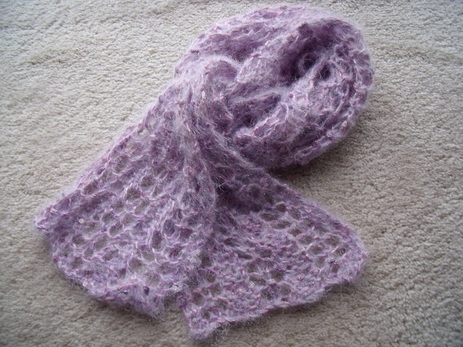 Tied view.  Close-up. The second one is the (rather short) scarf I wove for my mom:  Full view  Close-up with fringe. Today, I started off listening to another podcast. Unfortunately, it wasn't fantastically edited. It was exerts from a lecture about the textiles found on some mummies in China. I was really looking forward to it because the lecturer was the author of a book I'd really like to read, Women's Work: the First 20,000 years (her name is Elizabeth Wayland Barber). I heard her speak a little about the mummies, and about how well preserved their clothes were, but not much about the clothes themselves. She talked a little about how weaving spread from Mesopotamia to China, and then the lecture cut to a rather amusing tale about trying to chase down a rare sheep at a zoo for a fiber sample, and how she learned that the first wool for textiles could not have come from the sheep because the fiber was too delicate to spin. It sounds like it would have been a great lecture to attend but there must have been some time constraints for the length of the podcast and unfortunately, I didn't really get anything that I think would add to my education. It is a good reminder that I should look up the book though, which is as much a part of art history for me as a book about Manet would be. Next I read my design book. The chapter I was reading was on texture, which wasn't something I had really considered before. Some texture is implied, as on a two-dimensional surface, but it is very real on a three-dimensional surface. Sometimes paint can be used to create actual texture by layering with thick paint and using tools such as palette knives. Also, sand can be added to paint to make it more textured. Early in the 20th century, paper was added to paintings, a technique called paper colle (there should be an accent on the last e of colle). This led to collage, in which all sorts of items were added to paintings, such as rope or chair caning. Today, artists may use materials such as nails or other unlikely subjects. Simulated texture is texture that looks real but cannot be felt with the hand. These are imitations of actual texture. Abstract texture is artificial texture that does not imitate real life, but is symbolic of something we would see, such as simplified woodgrain. Invented texture does not look like anything known; instead, it comes from the artist's imagination. Texture can be combined with pattern to create a pattern on a three-dimensional surface, such as a rug with raised tufts where polka-dots are, or engraved swirls on a sculpture. Texture needs careful consideration in composition because texture can be so distracting that it can take away from the rest of the composition, so it needs to be carefully balanced. The composition needs to have rests, or places where the eyes don't need to look too hard, or the composition will look cluttered. Textures can imply space too: blurred, low contrast texture suggests distance, and sharp, strong contrast texture suggests closeness. Textures can have psychological implications. Texture is especially important in three-dimensional work such as sculpture. There is a type of sculpture called an assemblage, which is sort of like collage except that it is usually viewed in the center of the floor rather than on a wall, and can be viewed from many angles. It usually involves some found and some made materials. When assemblage is in a painting format, it tends to project from the wall. Texture can be used to trick the viewer into thinking that they are looking at another material, such as a realistic ceramic sculpture of a leather jacket hanging on a wall. I also discovered that my textbook has a corresponding interactive website: www.mhhe.com/artstudio. It's not quite as instructional as I would like, but I suppose if it was, there would be no reason to buy the textbook! However, I look forward to using the site to review once I am finished the book. Next, I finished off a drawing I have been working on since I arrived. I am quite pleased with it. I did it after I read the chapter on value. Although I did not use a value finder, the study helped me immensely. I look forward to making the value finder and improving my drawing even more. I should note that I used my blending stump as much as I used my pencil for this one. 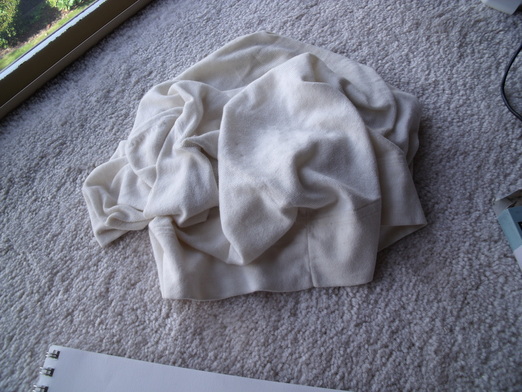 The subject. It was a cardigan that I fluffed and plopped down. Then the cat sat on it and I had to fluff it very carefully again. Finally, I worked on business study. My dad is an Excel genius and he helped me create a spreadsheet with my business plan. This is very handy, as I can tweak numbers here and there and the entire thing will recalculate itself for me. It's going to save me a lot of time! I asked my dad to create the spreadsheet for me but I suppose he took the "teach a man to fish" approach. I'm glad he did because it's not that difficult and now I can create any kind of spreadsheet I want.
Looks like tomorrow will be another free day. More studying then!
Sorry for the delay in posting this week. It’s been a crazy week so far and I haven’t been able to blog so far.
Monday, I wasn’t feeling well so I took a day off.
Tuesday was a bit nuts because I was preparing for my trip. The trip I am on now. I started out with business study, in which I watched several little podcasts on photography. I hope this improves my sucky product photos. So far, most of the podcasts have been about different cameras (none of which I possess) and the history of cameras. This is all interesting background info, but hasn’t really helped me yet. One podcast that did help me was about the rule of thirds in composition. I had heard of the rule of thirds but didn’t really understand it, so this was a great explanation. Basically, on a picture frame, things look really good when you divide the surface area into equal thirds and base your subject(s) in one or two of those areas. You can divide the surface horizontally, vertically, or even diagonally. The spots where horizontal and vertical thirds intersect are especially interesting points onto which you can place an important feature (such as eyes in the case of a portrait). I am not yet sure how this knowledge will affect my product photos, but I hope it will in the future.
In design, I finished the chapter about shape. I looked at proportions and economy. Sometimes artist will break a work down into planar shapes, perfecting each layer of work before moving onto the next. This helps the artist understand the relationship of all the shapes to each other. Shape can also be used for expressive content. Viewers react with different emotions to different shapes. Sometimes these reactions are shared with other viewers, and sometimes they are more personal. The meaning of shapes can be altered by the shapes themselves, by their colours, or by their values. In three-dimensional work, shape not only means the actual shape of the object, but also the shapes of the negative areas that are left by the work. Shapes can depend on the shadows they cast. The shapes also depend on the viewer’s position. A shape to take into consideration is the silhouette of the work.
Wednesday, I was in transit for most of the day so my studies were limited by that. I listened to a podcast about a French gardener who has a sort of dyestuff demonstration garden. He works with a botanist to try to grow every kind of plant that is used for dyeing, or at least as many as possible (henna, for example, doesn’t do very well in his climate in Provence). His garden is the main tourist attraction in his tiny village. A lot of his work with the public is about educating people on the uses of his plants. Different dyes can be used in different ways, and artists are always coming up with new and innovative ways to use the plants. Often, the traditional recipes can’t be used anymore because that is no longer the way dyes are used (he didn’t explain what he meant by that, but it could have something to do with increased safety practices over time, or the availability of different products that have to do with dyeing). His garden receives some funds from the government in the form of grants, and also from the dyeing association he belongs to. In this part of the podcast, he was looking for additional ways to raise money, and he was pretty sure he didn’t want to open a gift shop and sell traditional Provencal gift shop items such as lavender and goat cheese!
In design, I studied the chapter on value. I was excited about this chapter, as I am only sort of familiar with the concept of values. Value means, basically, relative degrees of lightness and darkness. The chapter mostly looked at black and white (and infinite shades of grey) values, also called achromatic values. The chapter includes a value scale that I can photocopy and use to help with my drawing. The lighter shades, from white to middle grey, are known as high-key values, and the darker shades, from middle grey to black, are low-key values. It will probably take me a little while to remember which is which. Some works use a limited range of values for dramatic effect, such as using only low-key values to create a somber mood. Different values can be achieved with different media, such as pencil, charcoal, or chalk, wet or dry, direct or blended, with lines or with shapes. Etchings can create strong contrasts between light and dark, as can woodcuts and screenprinting. The use of different values on a two-dimensional work can create the appearance of three-dimensionality. These are referred to as plastic values. Cast shadows are an important part of the composition of a work, as cast shadows in the wrong places can create a mess out of the image. Similarly, when there are not enough cast shadows, the image looks flat (which may or may not be a desired effect). The technique of gradually blending contrasting lights and darks is called chiaroscuro. This effect creates spaces that recede in the works. Tenebrism is extreme or exaggerated chiaroscuro, such as in the works of Rembrandt. Some art deliberately uses different values in such a way that they create a shallow space, as you can see in many traditional Asian artworks. Value pattern is a way of using dark and light values to create a pattern on the surface of the work, and can be used as a compositional element. Sometimes it is difficult for artists to see what kind of values they are using in colour, and when the work is translated to black and white, the values can be too similar (although that might also be a deliberate decision.) A closed-value composition means that values are contained within shapes which are used to contrast with one another. An open-value composition means that values cross over one another. Values are used in three-dimensional works in the shadows that they cast, or by the paint on the surface of the work.
I will not be able to do any surface design while I am on my trip. I have brought up some drawing tools, as well as my business book, my podcasts, my design book, and a little knitting. I hope to keep working on these subjects while I spend time in Canada trying to keep my status as a visitor in the United States legal. I can’t yet afford the fees for a spousal Greencard but I am chomping at the bit to get one so I can stop pissing myself every time I cross the border. I really hope I get back in again, as my husband and my stuff are stateside!
|
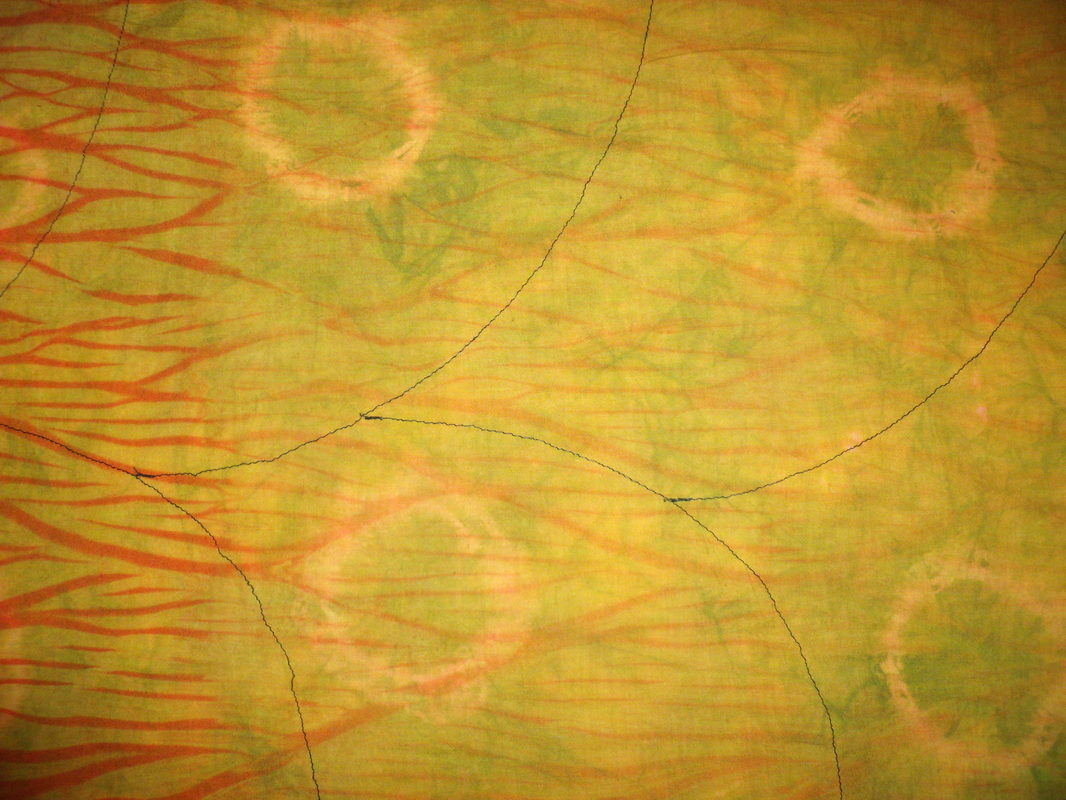
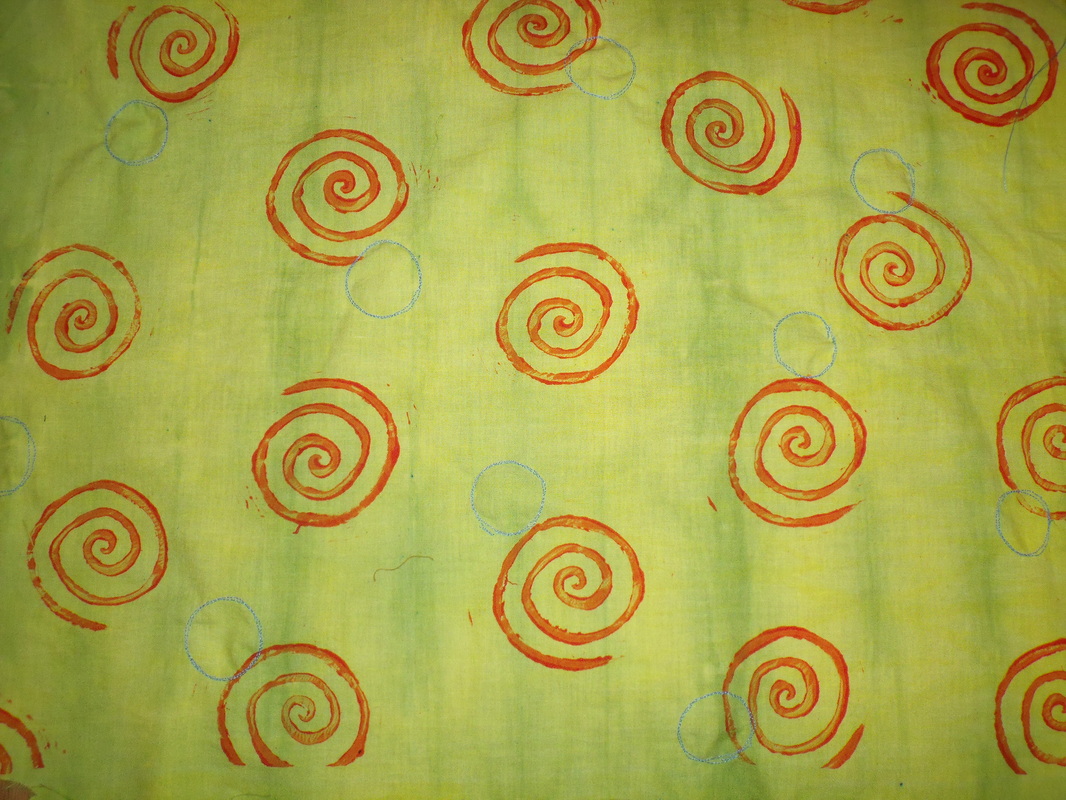
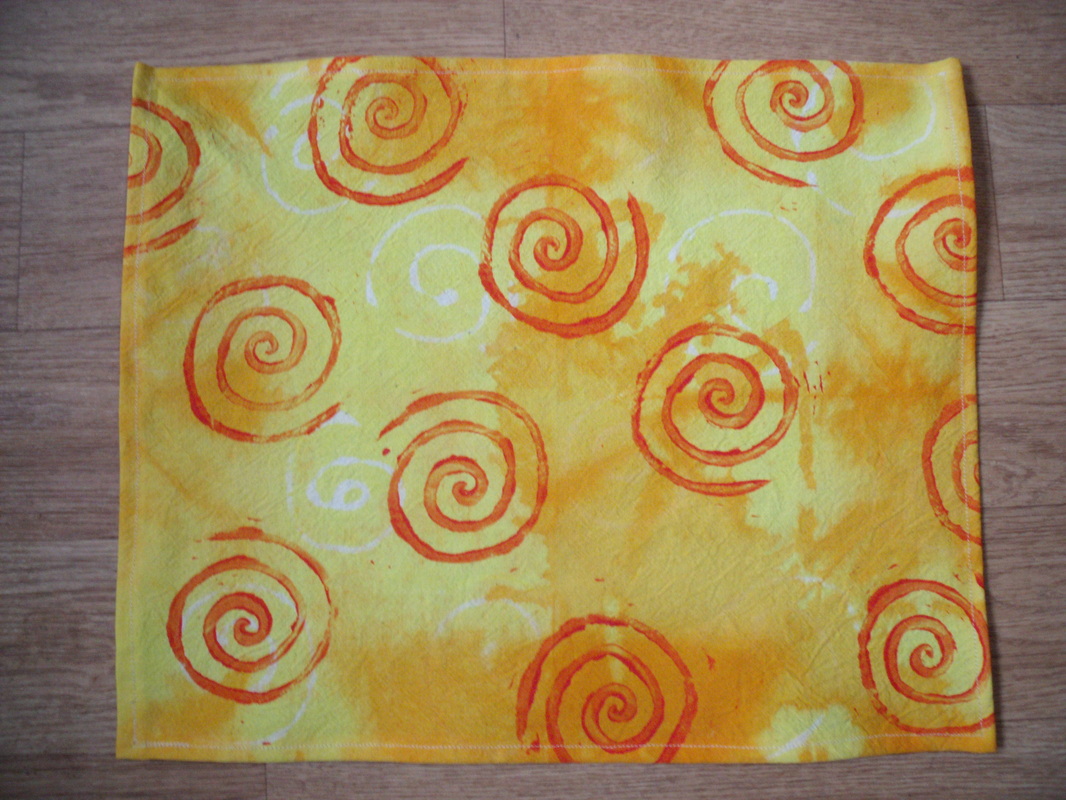



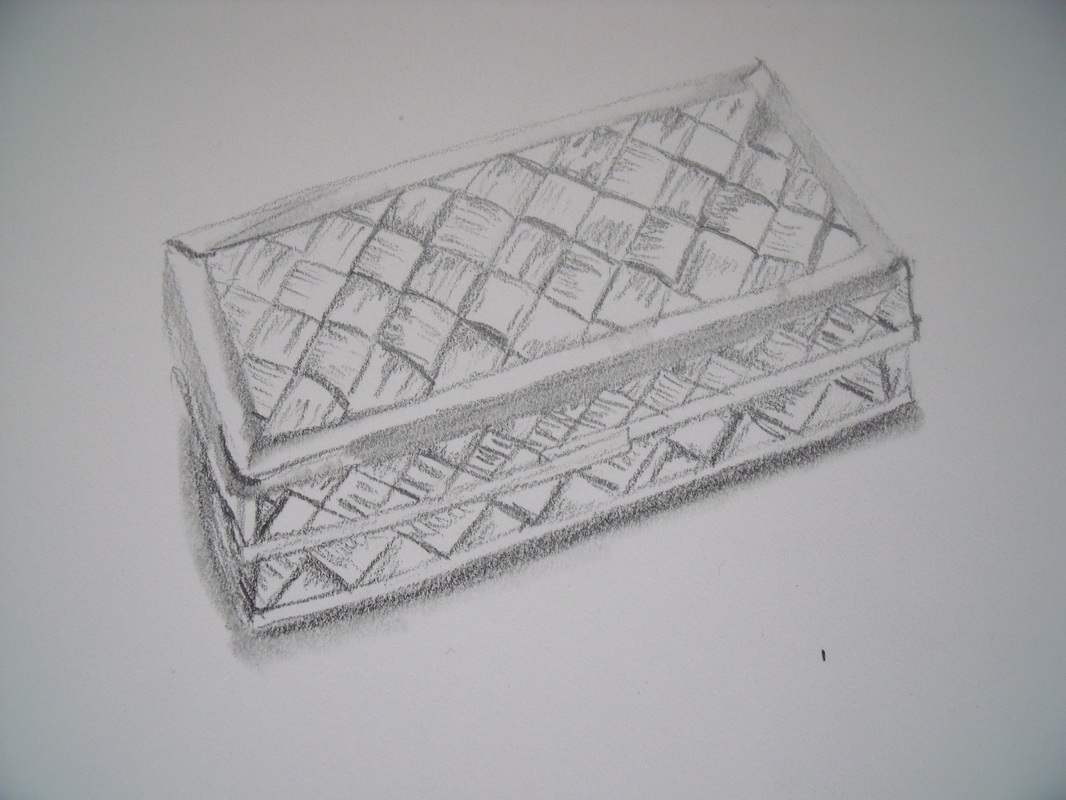










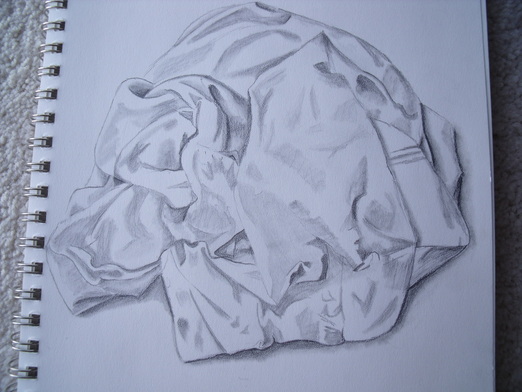


 RSS Feed
RSS Feed
